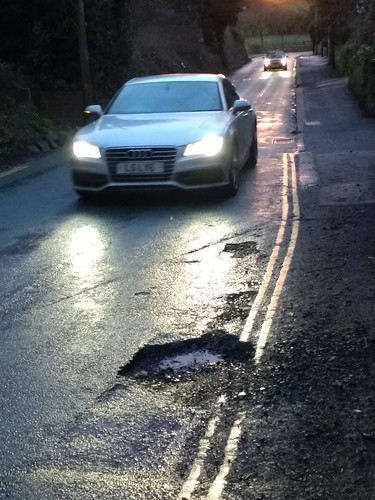
Pothole in Sandy Lane, Brewood
Part of the reason for these problems in the U.K. is the common practice of distributing services underground. Mains water, Gas, Electricity and Telecommunications, together with Drains for Surface Water and Foul Water (sewage) are typically buried in the ground, usually underneath the surface of a road. This is fine until repairs or alterations to any of the services are required, necessitating removing the road surface and digging-up the sub-soil until the required service is exposed. The obstruction of the carriageway creates traffic management problems, often addressed by traffic control using temporary traffic lights. The presence of the excavation, often a couple of metres in depth, also presents a danger to pedestrians, often dealt with by some form of temporary fencing. Requirements for signage to alert both pedestrians and vehicles to the temporary works further complicate matters.

Brewood Village: Temporary traffic lights and signage during connection of buried services to a house extension in Sandy Lane.
In the United Kingdom, I think mains water and drains are invariably buried. The same applies to domestic mains gas supplies but I was interested to discover (on my trip Caspian Odyssey) that in Armenia and neighbouring Georgia, gas is distributed above ground because volcanic activity can cause sufficient ground movement to damage buried pipework. In these countries, this seemed to result in an unsightly and sometimes rather'Heath-Robinson' arrangement of pipes, elbows and supporting brackets.
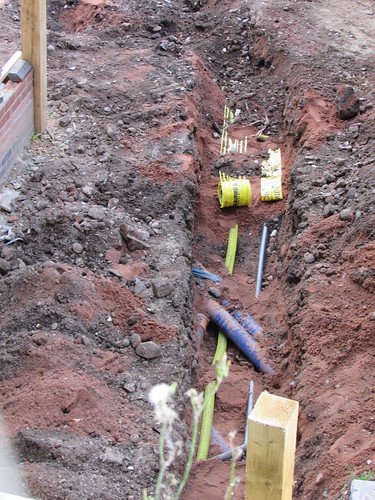
Brewood Village: Directly-buried underground services during connection to new houses in Sandy Lane. Note the printed identification tapes laid on top of the gas main (left) and water main (right).
Both electricity and telecommunications cables are sometimes carried above ground.

An underground multi-pair telecommmunications cable feeds a telegraph pole from where subscribers are connected by overhead 'drop-wires'.
Indeed, when telephones started to proliferate, they were initially invariably fed by two (less commonly, one) bare copper wires carried on ceramic insulators on the cross arms of 'telegraph poles'. In a built-up area, the number of circuits was visually intrusive but at least readily accessible for maintenance (if you had a head for heights).
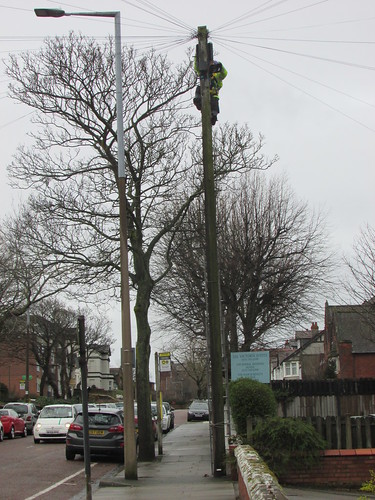
'Openreach' Lineman working on a British Telecom Distribution Pole in Victoria Road, New Brighton.
As the idea of generating mains electricity in one place and distributing it to consumers over a wider area grew, it was logical to copy the transmission methods used for telephones by using copper wires carried on porcelain insulators on wooden poles.
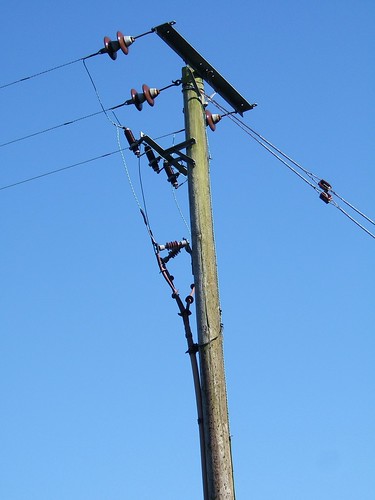
Three-phase 'Delta' connected overhead electricity transmission line on wooden pole, showing connection to multi-core insulated cable leading to a transformer at ground level. The pole is stayed by two stranded galvanised steel guy wires, each incorporating an 'egg' insulator.
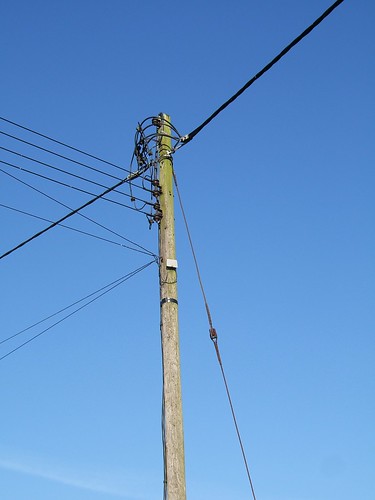
A 3-phase electricity supply being distributed by four insulated cables twisted together, carried overhead on wooden poles. A teed connection to a consumer is carried on four separate, parallel wires. Overhead 'drop-wires' for telephones are fed from an underground cable via a plastic terminal box. Note the 'Egg' insulator in the stranded galvanised steel guy wire.
As technology developed better electrical insulating techniques, it became possible to manufacture electrical cables where one tough, impervious sheath embraced a number of separate electrical conductors. For telephony, there might be many thin conductors capable of carrying a number of separate circuits. For power transmission, a small number of thick conductors were common. These cables could then be buried, removing the need for a series of poles to support the service.
Particularly for distributing telephone circuits in a built-up area, a large number of circuits would leave the exchange but then split to serve different groups of suppliers. This could conveniently be done by bringing the exchange cable into an accessible underground chamber where other cables could be interconnected, usually via an above-ground terminal cabinet allowing changes to the circuits provided and a convenient location for testing when faults occurred.
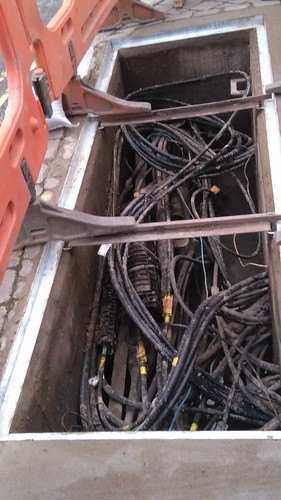
Termination chamber, Market Place, Brewood (during replacement of lid frame).
Power distribution often used inaccessible, buried joints to 'tee' power to individual users. In the 1950s, the Victorian house I was living in was finally connected to mains electricity (we'd previously only had mains water and gas). I was fascinated as the pavement was dug-up, the electric cable passing the house - the 'street main'- was located and the lead outer sheath removed to expose the individual three live phases, the neutral and (I think) the protective earth, each with its own electrical insulation. With what seemed to me very inadequate protective clothing and a few rubber mats to line the excavation, the jointer calmly attached the spur cable which would feed the house to one of the three phases, the neutral and the protective earth. Each joint was very carefully made and soldered for reliability. I presume some insulation was applied but I can't remember details. The remainder of the process involved making-good the sheath of the main cable and sealing the new spur cable so as to prevent the ingress of moisture. The joint closure was two pre-formed sheets of lead about two feet long, one fitted under the new joint, one on top so as to embrace the main cable, fitting snugly around the street main at each end of the joint and around the new spur cable. The two halves of the joint closure were held tightly together by bending over interlocking tabs at the edge of each sheet of lead before carefully heating the lead with a blowlamp and 'wiping' it with moleskin until a continuous, waterproof lead sheath had been created along the 'street main' and new spur cable.
Pictures around Brewood Village
The following album includes some examples of local services infrastructure:-
Brewood Village
